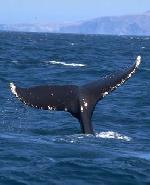Humpback
Whale
Home Page
Challenge
Questions

Search Journey North
return to:

 A/CPB
A/CPB
Humpback Whale Migration Update: May 13, 1998
Today's Report Includes
- Rain, Rain, Go Away...
- Latest Mother-calf Pair Sightings
- Other New Sightings
- Sad News On Truro Beach
- Responses To Challenge Question # 7
 To: Journey North
To: Journey NorthFrom: Anne Smrcina
Greetings from the Stellwagen Bank National
Marine Sanctuary.
Rain, Rain, Go Away...
The many whalewatching companies located in eastern Massachusetts are gearing up
for what they hope will be another great year for watching whales. The whales seem
to be cooperating -- the weather isn't. We've had rain almost non-stop since the
first of May. We've already passed (by a lot) the average rainfall for the month.
Not only have we had rain, but wind too. For whalewatching, rain is uncomfortable,
but wind makes sighting of whales (usually by their blows) nearly impossible.
Latest Mother-calf Pair Sightings
I mentioned in the last report that three mother-calf pairs had been identified.
That number is now up to 5, with Zipper and Pepper being added to the list.
Other New Sightings
In addition to those whales, other newly sighted whales include:
- Crystal
- Stellar
- Voltage
- Sundog
and the newly named whales:
- Pylon
- Patchwork (I was one of three people to suggest this name)
- Vader (as in Darth).
Sad News On Truro Beach
A dead yearling washed up on a beach in Truro, Mass. (can you find that on a map?) on May 5th. This one-year-old male, named Footsteps, was Firefly's calf. A cause of death has not yet been established. A necropsy was done on the carcass but the body had already deteriorated a lot before scientists could take a look. They were able to see some scarring on the head (that seemed to have started to heal) and which had not been in evidence the last time Footsteps was seen in September. Scientists are not sure if this injury was in any way connected with the whale's death.
This information came to me from Jooke Robbins, a research assistant at the Center for Coastal Studies in Provincetown.
 Responses
To Challenge Question # 7
Responses
To Challenge Question # 7In my last report I asked what you could tell from Salt's reproduction history about humpback whale reproduction and about possible concerns that scientists might have about Salt. Two classes did a nice job of answering that challenge question:
"I think that in looking at her calves and the years that there is only about a 2yr.-3yr.between having another calf, so when she had Salsa in 1991, they thought they would see her with a new calf in either 1993 or 1994, when they didn't they most likely got worried that something was wrong with her, that she may have a problem with either getting pregnant or having alive baby, but now since they saw her with her new baby they know everything is going to be o.k." Kuwani@aol.com
"You can tell that humpback whales reproduce every two years. A worry of scientists may have occured between 1991 and 1998 because Salt didn't birth any calves during that time. This could have meant infertility or that she'd become single, without a mate." Melih Onvural melih@ipass.net
As the two classrooms noticed, if you look at the dates for Salt's calves, you will see a pattern. Most births were separated by 2-3 years. That seems to be a normal pattern. Humpback whales become fertile at about 5-6 years of age; they give birth and nurse for around a year, then are ready to conceive and give birth to another calf the following year.
Right whales have a slightly longer period between births -- usually 3-5 years. This may be one of the reasons why humpback whale populations seem to be growing and the right whale population is at such a critically low number.
Scientists were concerned about Salt because of the very long time period between her last two calves. At first it was thought that she had reached the age where she was not fertile anymore. But since she showed up with a calf, it has been suggested that she did conceive but lost the calves early in her pregnancy or shortly after birth (most calves are not sighted in the calving grounds but up north after they have made the first migration to the feeding grounds).
Humpback reproduction dates were documented with a 1980 calf named Beltane. She gave birth to her own calf in 1985. So scientists know that humpback whales can become pregnant as early as four years of age.
That's all for this report. This is Anne Smrcina, education coordinator of the Stellwagen Bank National Marine Sanctuary, signing off.
Anne Smrcina
Education Coordinator
Stellwagen Bank National Marine Sanctuary
|
|
Journey North |
The FINAL Humpback Whale Migration Update will Be Posted on May 27, 1998.






